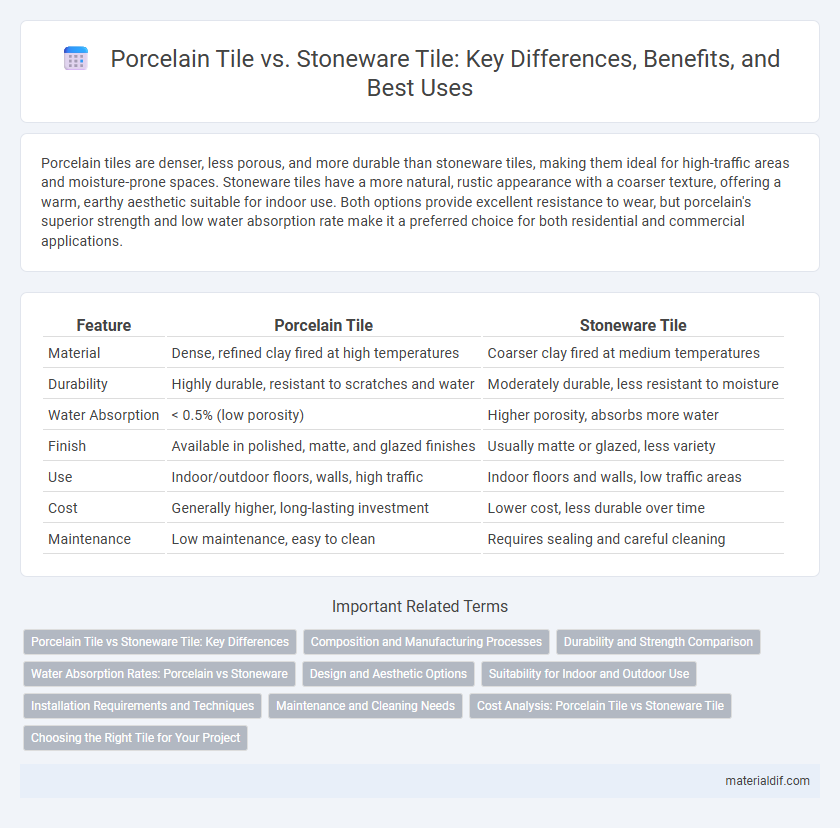Porcelain tiles are denser, less porous, and more durable than stoneware tiles, making them ideal for high-traffic areas and moisture-prone spaces. Stoneware tiles have a more natural, rustic appearance with a coarser texture, offering a warm, earthy aesthetic suitable for indoor use. Both options provide excellent resistance to wear, but porcelain's superior strength and low water absorption rate make it a preferred choice for both residential and commercial applications.
Table of Comparison
| Feature | Porcelain Tile | Stoneware Tile |
|---|---|---|
| Material | Dense, refined clay fired at high temperatures | Coarser clay fired at medium temperatures |
| Durability | Highly durable, resistant to scratches and water | Moderately durable, less resistant to moisture |
| Water Absorption | < 0.5% (low porosity) | Higher porosity, absorbs more water |
| Finish | Available in polished, matte, and glazed finishes | Usually matte or glazed, less variety |
| Use | Indoor/outdoor floors, walls, high traffic | Indoor floors and walls, low traffic areas |
| Cost | Generally higher, long-lasting investment | Lower cost, less durable over time |
| Maintenance | Low maintenance, easy to clean | Requires sealing and careful cleaning |
Porcelain Tile vs Stoneware Tile: Key Differences
Porcelain tile differs from stoneware tile primarily in density and water absorption, with porcelain exhibiting a lower water absorption rate below 0.5%, making it more durable and suitable for high-moisture areas. Porcelain is fired at higher temperatures, resulting in a harder, more scratch-resistant surface compared to the slightly more porous and softer stoneware tile. These key differences impact their applications, with porcelain tiles preferred for both indoor and outdoor use, while stoneware is often used in less demanding, indoor settings.
Composition and Manufacturing Processes
Porcelain tiles are made from dense, fine-grained clays fired at high temperatures exceeding 1200degC, resulting in a vitrified, non-porous surface with high durability. Stoneware tiles consist of coarser clay mixtures, fired at slightly lower temperatures around 1100-1200degC, producing a more porous and less dense material with a natural matte finish. The advanced manufacturing process of porcelain involves a combination of precise clay blending, molding, and longer kiln firing times to achieve superior strength compared to stoneware.
Durability and Strength Comparison
Porcelain tile offers superior durability and strength compared to stoneware tile due to its higher density and lower porosity, making it more resistant to chipping, cracking, and moisture absorption. Porcelain's manufacturing process involves firing at higher temperatures, resulting in a harder surface that withstands heavy foot traffic and harsh environmental conditions better than stoneware. Stoneware tile, while still durable, tends to be less dense and more porous, which can affect its longevity and strength under rigorous use.
Water Absorption Rates: Porcelain vs Stoneware
Porcelain tile exhibits significantly lower water absorption rates, typically less than 0.5%, making it highly resistant to moisture and ideal for wet environments. Stoneware tile absorbs more water, generally between 3% and 7%, which can lead to increased vulnerability to stains and damage in humid conditions. This difference in water absorption is a key factor influencing durability and suitability for various indoor and outdoor applications.
Design and Aesthetic Options
Porcelain tiles offer a broader range of design and aesthetic options compared to stoneware tiles, featuring diverse patterns, colors, and finishes that mimic natural stone, wood, and even fabric textures. Their fine-grain composition allows for high-definition prints and intricate surface details, enhancing visual appeal in residential and commercial spaces. Stoneware tiles, while durable, typically present earthier tones and a more rustic appearance, making porcelain the preferred choice for versatile, modern interior designs.
Suitability for Indoor and Outdoor Use
Porcelain tile offers superior durability and low water absorption, making it highly suitable for both indoor and outdoor applications, including high-traffic areas and moisture-prone environments. Stoneware tile, while robust and aesthetically pleasing, has higher porosity and is better suited for indoor use where exposure to weather and heavy wear is limited. The dense composition of porcelain tile ensures resistance to frost and UV rays, providing long-lasting performance in exterior settings compared to stoneware.
Installation Requirements and Techniques
Porcelain tiles require a precise substrate preparation with a smooth, level surface to prevent cracking during installation, often benefiting from a thin-set mortar for strong adhesion. Stoneware tiles, typically thicker and more porous, demand a more robust backer board or cementitious substrate to support their weight and reduce moisture absorption risks. Both materials need careful grout selection and sealing techniques, but porcelain's low porosity often results in less frequent sealing compared to stoneware.
Maintenance and Cleaning Needs
Porcelain tiles require minimal maintenance due to their dense, non-porous surface, making them highly resistant to stains and moisture, and easy to clean with just mild detergent and water. Stoneware tiles, being more porous, demand regular sealing to prevent moisture absorption and staining, and often require specialized cleaners to maintain their appearance. Both materials benefit from routine sweeping and mopping, but porcelain's durability and lower upkeep make it a preferred choice for high-traffic areas.
Cost Analysis: Porcelain Tile vs Stoneware Tile
Porcelain tiles generally cost more than stoneware tiles due to their denser material and higher manufacturing standards, with prices ranging from $3 to $10 per square foot compared to stoneware's $2 to $7 per square foot. Porcelain's durability and low porosity reduce long-term maintenance expenses, making it a cost-effective choice despite the higher initial investment. Stoneware tiles, while more affordable upfront, may require more frequent sealing and repairs, increasing overall ownership costs over time.
Choosing the Right Tile for Your Project
Porcelain tiles offer superior durability, water resistance, and a refined appearance compared to stoneware tiles, making them ideal for high-traffic or moisture-prone areas. Stoneware tiles, characterized by their denser, more porous structure, provide a rustic aesthetic and are often chosen for decorative or low-traffic applications. Selecting between porcelain and stoneware hinges on project requirements such as durability, exposure to moisture, and design preferences.
Porcelain Tile vs Stoneware Tile Infographic

 materialdif.com
materialdif.com